Modelling Strategies for the Updating of Infilled RC Building FEMs Considering the Construction Phases
Abstract
:1. Introduction
2. Modelling Strategies for the FEM Updating of Buildings
- geometry of the model and modelled elements;
- soil-structure interaction;
- concrete elastic modulus;
- modelling strategies for floor slabs;
- mechanical properties of infill masonry walls;
- load and mass.
2.1. The Common Design FEM
2.2. Modelling of the Soil-Structure Interaction
2.3. Modelling of the Experimental Value and the Time Evolution of Concrete Elastic Modulus
2.4. Modelling of the Floor Slabs
2.5. Modelling of the Nonstructural Elements
2.6. Modelling of Load and Mass
3. FEM Updating of a Building Case Study during Construction Phases
3.1. Building Description
3.2. Building FEM Updating
3.2.1. Common Design FEM Updating Considering Construction Phases
3.2.2. Model Updating Considering the Soil−Structure Interaction
3.2.3. Model Updating Considering the Experimental Value and Time Evolution of Concrete Elastic Modulus
3.2.4. Model Updating Considering the Floor Slabs
3.2.5. Model Updating Considering the Nonstructural Elements
3.2.6. Model Updating Considering Actual Load and Mass
4. Validation of the FEM Updating for the Building Case Study
5. Conclusions
- At first, the modelling strategies to refine FEMs are treated, starting from the common design FEM, which is usually very simple and built considering manifold simplifying assumptions. Recommendations about how to accurately model the geometry of the buildings, the soil−structure interaction, the elastic modulus of concrete, the floor slabs, the infill walls, and the actual load and mass on the structure are reported.
- The evolution of the above parameters during the construction process of a building is addressed as well, proposing modelling strategies to be adopted for modelling a building during its construction.
- An application to a real building case study is provided at the end. The considered building has been widely investigated during its construction, also performing static and dynamic in-situ tests that allowed the determination of the global dynamics, as well as the mechanical properties of the construction materials and components. A stepwise model updating adopting the proposed modelling strategies is then performed, realizing and updating eight FEMs that represent the eight main construction phases. The numerical outcomes reached from the eight models are compared with the relevant experimental ones, and the comparison shows a very good agreement, demonstrating the effectiveness of the proposed model updating strategies and the correctness of the construction procedure for the building at hand.
Author Contributions
Funding
Institutional Review Board Statement
Informed Consent Statement
Data Availability Statement
Acknowledgments
Conflicts of Interest
References
- Mottershead, J.E.; Link, M.; Friswell, M.I. The sensitivity method in finite element model updating: A tutorial. Mech. Sist. Signal Proc. 2011, 25, 2275–2296. [Google Scholar] [CrossRef]
- Mottershead, J.E.; Friswell, M.I. Model updating in structural dynamics: A survey. J. Sound. Vib. 1993, 167, 347–375. [Google Scholar] [CrossRef]
- Blaz, K.; Bostjan, B.; Wai Kei, A. Model updating of seven-storey cross-laminated timber building designed on frequency-response-functions-based modal testing. Struct. Infrastruct. Eng. 2023, 19, 178–196. [Google Scholar] [CrossRef]
- Garcia-Marcias, E.; Ierimonti, L.; Venanzi, I.; Ubertini, F. An innovative methodology for online surrogate-based model updating of historic buildings using monitoring data. Int. J. Arch. Herit. 2021, 15, 92–112. [Google Scholar] [CrossRef]
- Ceravolo, R.; De Lucia, G.; Miraglia, G.; Pecorelli, M.L. Thermoelastic finite element model updating with application to monumental buildings. Comput. Aided Civil Infr. Eng. 2020, 35, 628–642. [Google Scholar] [CrossRef]
- Imregun, M.; Sanliturk, K.Y.; Ewins, D.J. Finite element model updating using frequency response function data–I, Theory and initial investigation. Mech. Syst. Sig. Process. 1995, 9, 187–202. [Google Scholar] [CrossRef]
- Sivori, D.; Lepidi, M.; Cattari, S. Structural identification of the dynamic behaviour of floor diaphragms in existing buildings. Smart Struct. Syst. 2021, 27, 173–191. [Google Scholar] [CrossRef]
- Falcone, R.; Lima, C.; Martinelli, E. Soft computing techniques in structural and earthquake engineering: A literature review. Eng. Struct. 2020, 207, 110269. [Google Scholar] [CrossRef]
- Salehi, H.; Burgueno, R. Emerging artificial intelligence methods in structural engineering. Eng. Struct. 2018, 171, 170–189. [Google Scholar] [CrossRef]
- Ierimonti, L.; Venanzi, I.; Cavalagli, N.; Comodini, F.; Ubertini, F. An innovative continuous Bayesian model updating method for base-isolated RC buildings using vibration monitoring data. Mech. Syst. Sig. Process. 2020, 139, 106600. [Google Scholar] [CrossRef]
- Akhlaghi, M.M.; Bose, S.; Green, P.L.; Babak, M.; Stavridis, A. Bayesian model updating of a five-story building using Zero-Variance sampling method. In Proceedings of the Society for Experimental Mechanics Series–37th IMAC, A Conference and Exposition on Structural Dynamics, Orlando, FL, USA, 28–31 January 2019. Code 225789. [Google Scholar]
- Lam, H.-F.; Hu, J.; Zhang, F.-L.; Ni, Y.-C. Markov chain Monte Carlo-based Bayesian model updating of a sailboat-shaped building using a parallel technique. Eng. Struct. 2019, 193, 12–27. [Google Scholar] [CrossRef]
- Rosati, I.; Fabbrocino, G.; Rainieri, C. A discussion about the Douglas-Reid model updating method and its prospective application to continuous vibration-based SHM of a historical building. Eng. Struct. 2022, 273, 115058. [Google Scholar] [CrossRef]
- Boscato, G.; Russo, S.; Ceravolo, R.; Fragonara, L.Z. Global sensitivity-based model updating for heritage structures. Comput. Aided Civ. Inf. 2015, 30, 620–635. [Google Scholar] [CrossRef]
- Aloiso, A.; Pasca, D.; Tomasi, R.; Fragiacomo, M. Dynamic identification and model updating of an eight-storey CLT building. Eng. Struct. 2020, 213, 110593. [Google Scholar] [CrossRef]
- Pan, Y.; Ventura, C.E.; Xiong, H.; Zhang, F.-L. Model updating and seismic response of a super tall building in Shanghai. Comput. Struct. 2020, 239, 106285. [Google Scholar] [CrossRef]
- Gentile, C.; Saisi, A. FE modeling of a historic masonry tower and vibration-based systematic model tuning. Adv. Mat. Res. 2010, 133–134, 435–440. [Google Scholar] [CrossRef]
- Foti, D.; Gattulli, V.; Potenza, F. Output-only identification and model updating by dynamic testing in unfavorable conditions of a seismically damaged building. Comput. Aided Civil Infr. Eng. 2014, 29, 659–675. [Google Scholar] [CrossRef]
- Astroza, R.; Alessandri, A. Effects of model uncertainty in nonlinear structural finite element model updating by numerical simulation of building structures. Struct. Control Health Monit. 2019, 26, e2297. [Google Scholar] [CrossRef]
- United States Geological Survey, USGS. Available online: https://www.usgs.gov/news/featured-story/magnitude-78-earthquake-nurdagi-turkey (accessed on 6 February 2022).
- Bovo, M.; Tondi, M.; Savoia, M. Infill Modelling Influence on Dynamic Identification and Model Updating of Reinforced Concrete Framed Buildings. Adv. Civ. Eng. 2020, 2020, 9384080. [Google Scholar] [CrossRef]
- Pepe, V.; De Angelis, A.; Pecce, M.R. Damage assessment of an existing RC infilled structure by numerical simulation of the dynamic response. J. Civ. Struct. Health Monit. 2019, 9, 385–395. [Google Scholar] [CrossRef]
- Nicoletti, V.; Arezzo, D.; Carbonari, S.; Gara, F. Detection of infill wall damage due to earthquakes from vibration data. Earthq. Eng. Struct. Dyn. 2023, 52, 460–481. [Google Scholar] [CrossRef]
- Kammer, D.C. Sensor placement for on-orbit modal identification and correlation of large space structures. J. Guid. Control. Dyn. 1991, 14, 251–259. [Google Scholar] [CrossRef]
- Taher, S.A.; Li, J.; Fang, H. Simultaneous seismic input and state estimation with optimal sensor placement for building structures using incomplete acceleration measurements. Mech. Syst. Sig. Proc. 2023, 188, 110047. [Google Scholar] [CrossRef]
- Zhou, Z.; Zhao, X.; Chong, P.H.J. Optimal relay node placement in wireless sensor network for smart buildings metering and control. In Proceedings of the 2013 15th IEEE International Conference on Communication Technology, Guilin, China, 17–19 November 2013; pp. 456–461. [Google Scholar] [CrossRef]
- Kalakonas, P.; Silva, V. Earthquake scenarios for building portfolios using artificial neural networks: Part II—Damage and loss assessment. Bull. Earthq. Eng. 2022. [Google Scholar] [CrossRef]
- Zeng, D.; Zhang, H.; Wang, C. Modelling correlated damage of spatially distributed building portfolios under scenario tropical cyclones. Struct. Saf. 2020, 87, 101978. [Google Scholar] [CrossRef]
- Ventura, A.; De Biagi, V.; Chiaia, B. Structural robustness of RC frame buildings under threat-independent damage scenarios. Struct. Eng. Mech. 2018, 65, 689–698. [Google Scholar] [CrossRef]
- Gara, F.; Arezzo, D.; Nicoletti, V.; Carbonari, S. Monitoring the Modal Properties of an RC School Building during the 2016 Central Italy Seismic Swarm. J. Struct. Eng. (ASCE) 2021, 147, 05021002. [Google Scholar] [CrossRef]
- Bronkhorst, A.J.; Moretti, D.; Geurts, C.P.W. Vibration Threshold Exceedances in the Groningen Building Vibration Monitoring Network. Front. Built Environ. 2021, 7, 703247. [Google Scholar] [CrossRef]
- Zong, Y.; Wan, F.; Hua, Y.; Liao, B.; Zhu, S.; Zhu, S. EEMD-Wavelet Adaptive Threshold Function Denoising and Its Application in Damage Monitoring of Aviation Connection Structure. In Proceedings of the 2021 Global Reliability and Prognostics and Health Management, PHM-Nanjing, Nanjing, China, 15–17 October 2021; p. 174772. [Google Scholar] [CrossRef]
- Bado, M.F.; Tonelli, D.; Poli, F.; Zonta, D.; Casas, J.R. Digital Twin for Civil Engineering Systems: An Exploratory Review for Distributed Sensing Updating. Sensors 2022, 22, 3168. [Google Scholar] [CrossRef]
- Nicoletti, V.; Martini, R.; Carbonari, S.; Gara, F. Operational Modal Analysis as a Support for the Development of Digital Twin Models of Bridges. Infrastructures 2023, 8, 24. [Google Scholar] [CrossRef]
- Shim, C.-S.; Dang, N.-S.; Lon, S.; Jeon, C.-H. Development of a bridge maintenance system for prestressed concrete bridges using 3D digital twin model. Struct. Infrastruct. Eng. 2019, 15, 1319–1332. [Google Scholar] [CrossRef]
- Tedjo, C.; Berawi, M.A.; Sari, M. Development of Blockchain and Machine Learning System in the Process of Construction Planning Method of the Smart Building to Save Cost and Time. In Proceedings of the 5th International Conference on Rehabilitation and Maintenance in Civil Engineering, ICRMCE, Surakarta, Indonesia, 8–9 July 2021; p. 282689. [Google Scholar] [CrossRef]
- Andrich, W.; Daniotti, B.; Pavan, A.; Mirarchi, C. Check and Validation of Building Information Models in Detailed Design Phase: A Check Flow to Pave the Way for BIM Based Renovation and Construction Processes. Buildings 2022, 12, 154. [Google Scholar] [CrossRef]
- Liu, Z.; Xing, Z.; Huang, C.; Du, X. Digital twin modeling method for construction process of assembled building. Jianzhu Jiegou Xuebao/J. Build. Struct. 2021, 42, 213–222. [Google Scholar] [CrossRef]
- Wang, Z.; Huang, M.; Gu, J. Temperature effects on vibration-based damage detection of a reinforced concrete slab. Appl. Sci. 2020, 10, 2869. [Google Scholar] [CrossRef] [Green Version]
- Zhou, Y.; Zhou, Y.; Yi, W.; Chen, T.; Tan, D.; Mi, S. Operational modal analysis and rational finite-element model selection for ten high-rise buildings based on on-site ambient vibration measurements. J. Perform. Constr. Facil. 2017, 31, 04017043. [Google Scholar] [CrossRef] [Green Version]
- Astroza, R.; Ebrahimian, H.; Conte, J.P.; Restrepo, J.I.; Hutchinson, T.C. Influence of the construction process and nonstructural components on the modal properties of a five-story building. Earthq. Eng. Struct. Dyn. 2016, 45, 1063–1084. [Google Scholar] [CrossRef]
- Kokalanov, V.; Trifunac, M.D.; Gicev, V.; Kocaleva, M.; Stojanova, A. High frequency calibration of a finite element model of an irregular building via ambient vibration measurements. Soil Dyn. Earthq. Eng. 2022, 153, 107005. [Google Scholar] [CrossRef]
- Butt, F.; Omenzetter, P. Finite element model calibration of an instrumented RC building based on seismic excitation including non-structural components and soil-structure-interaction. In Proceedings of the 22nd Australasian Conference on the Mechanics of Structures and Materials, ACMSM 2012, Sydney, Australia, 11–14 December 2012; p. 98302, ISBN 978-041563318-5. [Google Scholar]
- Nicoletti, V.; Arezzo, D.; Carbonari, S.; Gara, F. Vibration-Based Tests and Results for the Evaluation of Infill Masonry Walls Influence on the Dynamic Behaviour of Buildings: A Review. Arch. Comput. Methods Eng. 2022, 29, 3773–3787. [Google Scholar] [CrossRef]
- Van Overschee, P.; De Moor, B. Subspace Identification for Linear Systems: Theory–Implementation–Applications; Kluwer Academic Publishers: Dordrecht, The Netherlands, 1996. [Google Scholar]
- Allemang, R.J.; Brown, D.L. A correlation coefficient for modal vector analysis. In Proceedings of the 1st Int. Modal Analysis Conference, Bethel, CT, USA, 8–10 November 1982; pp. 110–115. [Google Scholar]
- Friswell, M.I.; Inman, D.J.; Pilkey, D.F. Direct updating of damping and stiffness matrices. AIAA J. 1998, 36, 491–493. [Google Scholar] [CrossRef] [Green Version]
- Carvalho, J.; Datta, B.N.; Gupta, A.; Lagadapati, M. A direct method for model updating with incomplete measured data and without spurious modes. Mech. Syst. Signal Process. 2007, 21, 2715–2731. [Google Scholar] [CrossRef]
- Rezvan, S.; Moradi, M.J.; Dabiri, H.; Daneshvar, K.; Karakouzian, M.; Farhangi, V. Application of Machine Learning to Predict the Mechanical Characteristics of Concrete Containing Recycled Plastic-Based Materials. Appl. Sci. 2023, 13, 2033. [Google Scholar] [CrossRef]
- Léger, P.; Paultre, P.; Nuggihalli, R. Elastic analysis of frames considering panel zones deformations. Comput. Struct. 1991, 39, 689–697. [Google Scholar] [CrossRef]
- EN 1992-1-1; Design of Concrete Structures–Part 1-1: General Rules and Rules for Buildings. European Committee for Standardization (CEN): Brussels, Belgium, 2015.
- D.M.17.01.2018; Aggiornamento delle «Norme Tecniche per le Costruzioni». Ministero Rome, Italy delle Infrastrutture e dei Trasporti: Rome, Italy, 2018. (In Italian)
- Carbonari, S.; Dezi, F.; Gara, F.; Leoni, G. Seismic response of reinforced concrete frames on monopile foundations. Soil Dyn. Earthq. Eng. 2014, 67, 326–344. [Google Scholar] [CrossRef]
- Gazetas, G.; Makris, N. Dynamic pile-soil-pile interaction. Part I: Analysis of axial vibration. Earthq. Eng. Struct. Dyn. 1991, 20, 115–132. [Google Scholar] [CrossRef]
- Makris, N.; Gazetas, G. Dynamic pile-soil-pile interaction. Part II: Lateral and seismic response. Earthq. Eng. Struct. Dyn. 1992, 21, 145–162. [Google Scholar] [CrossRef]
- Gazetas, G. Foundation vibrations. In Foundation Engineering Handbook; Fang, H.-Y., Ed.; Springer: Berlin/Heidelberg, Germany, 1991. [Google Scholar]
- Lydon, F.D.; Balendran, R.V. Some observations on elastic properties of plain concrete. Cem. Concr. Res. 1986, 16, 314–324. [Google Scholar] [CrossRef]
- Neville, A.M. Properties of Concrete, 5th ed.; The Royal Accademy of Engineering; Pearson: London, UK, 2011. [Google Scholar]
- Popovics, J.S.; Zemajtis, J.; Shkolnik, I. ACI-CRC Final Report—“A Study of Static and Dynamic Modulus of Elasticity of Concrete”; ACI-American Concrete Institute: Urbana, IL, USA, 2008. [Google Scholar]
- Choudhauri, N.K.; Kumar, A.; Kumar, Y.; Gupta, R. Evaluation of elastic moduli of concrete by ultrasonic velocity. In Proceedings of the National Seminar of ISNT, Chennai, India, 5–7 December 2002. [Google Scholar]
- Fédération Internationale du Béton (fib). Fib Model Code for Concrete Structures 2010; Ernst & Sohn: Berlin, Germany, 2013. [Google Scholar]
- Nicoletti, V.; Arezzo, D.; Carbonari, S.; Gara, F. Expeditious methodology for the estimation of infill masonry wall stiffness through in-situ dynamic tests. Constr. Build. Mater. 2020, 262, 120807. [Google Scholar] [CrossRef]
- Li, H.; Li, J.; Farhangi, V. Determination of piers shear capacity using numerical analysis and machine learning for generalization to masonry large scale walls. Structures 2023, 49, 443–466. [Google Scholar] [CrossRef]
- Nicoletti, V.; Arezzo, D.; Carbonari, S.; Gara, F. Dynamic monitoring of buildings as a diagnostic tool during construction phases. J. Build. Eng. 2022, 46, 103764. [Google Scholar] [CrossRef]
- SAP2000 Advanced; Static and Dynamic Finite Element Analysis of Structures. CSI Computer & Structures, Inc.: Berkeley, NJ, USA, 2021.
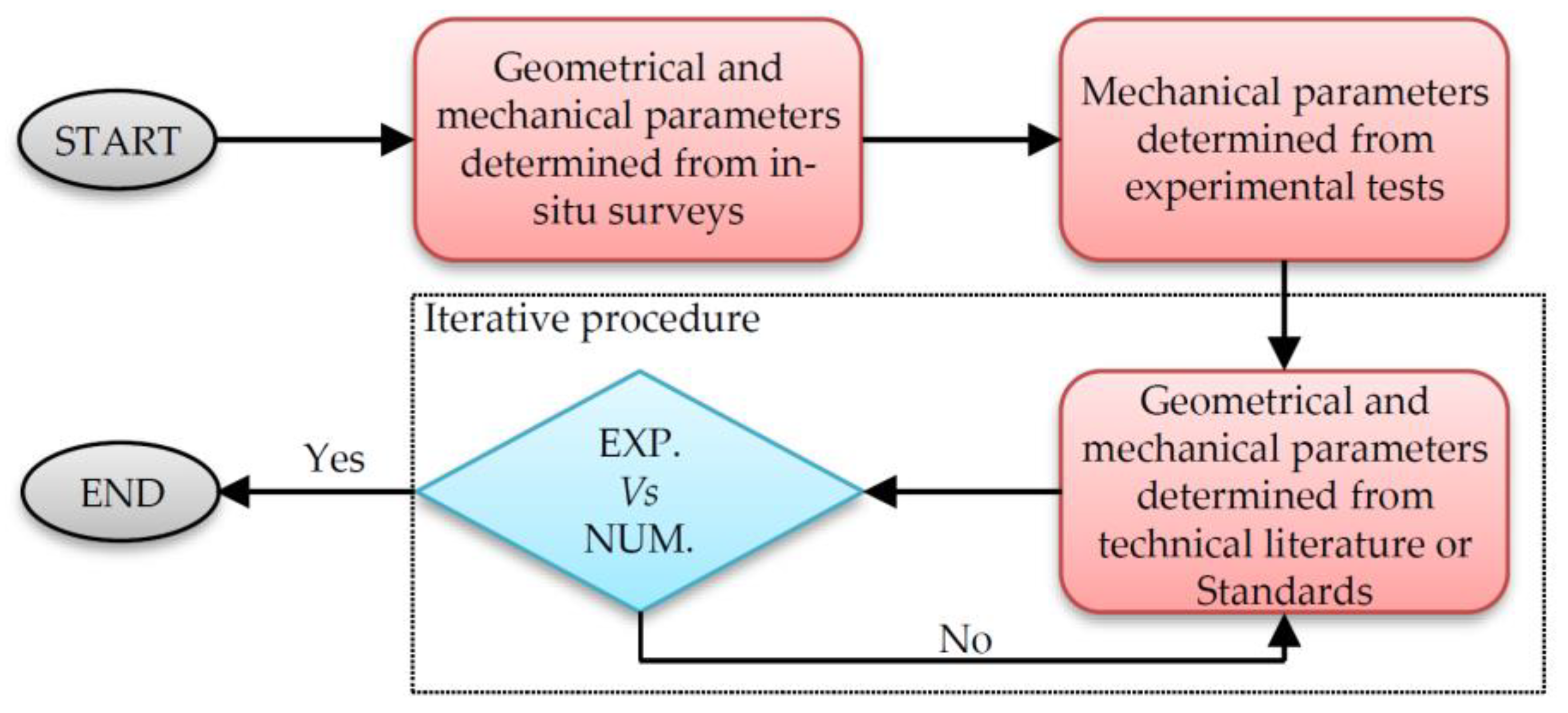

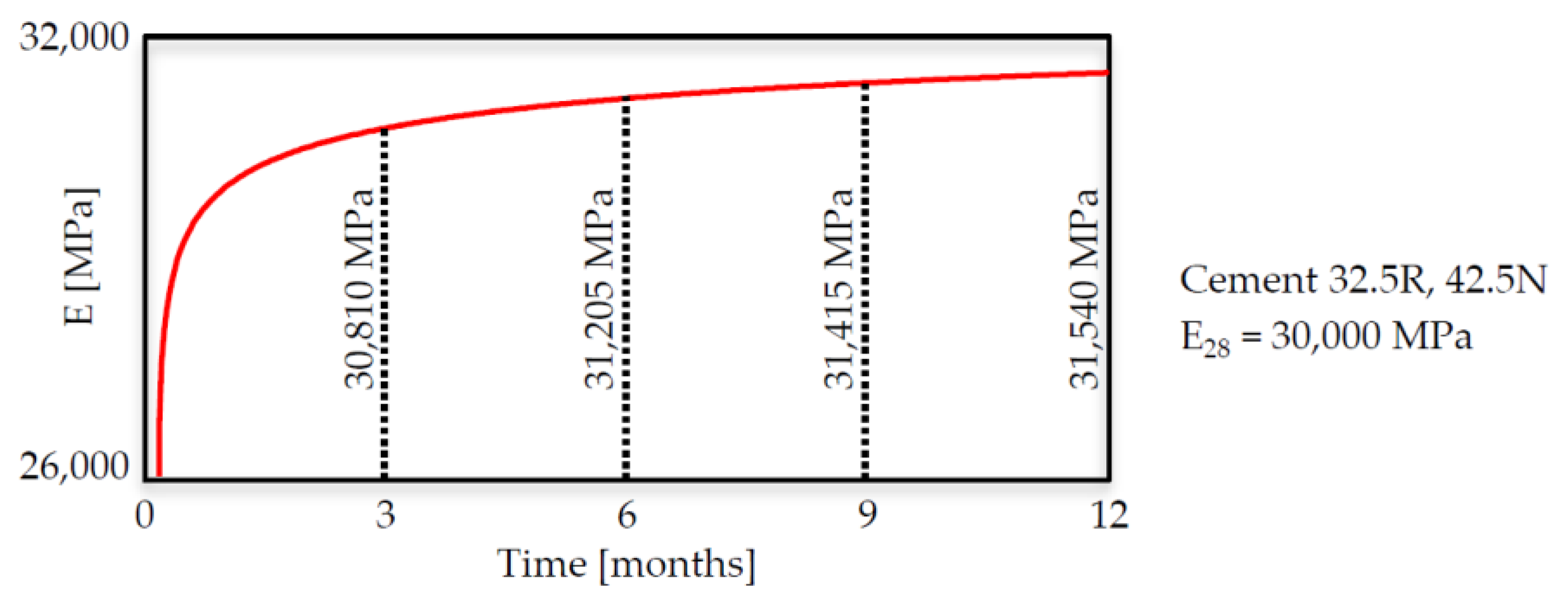

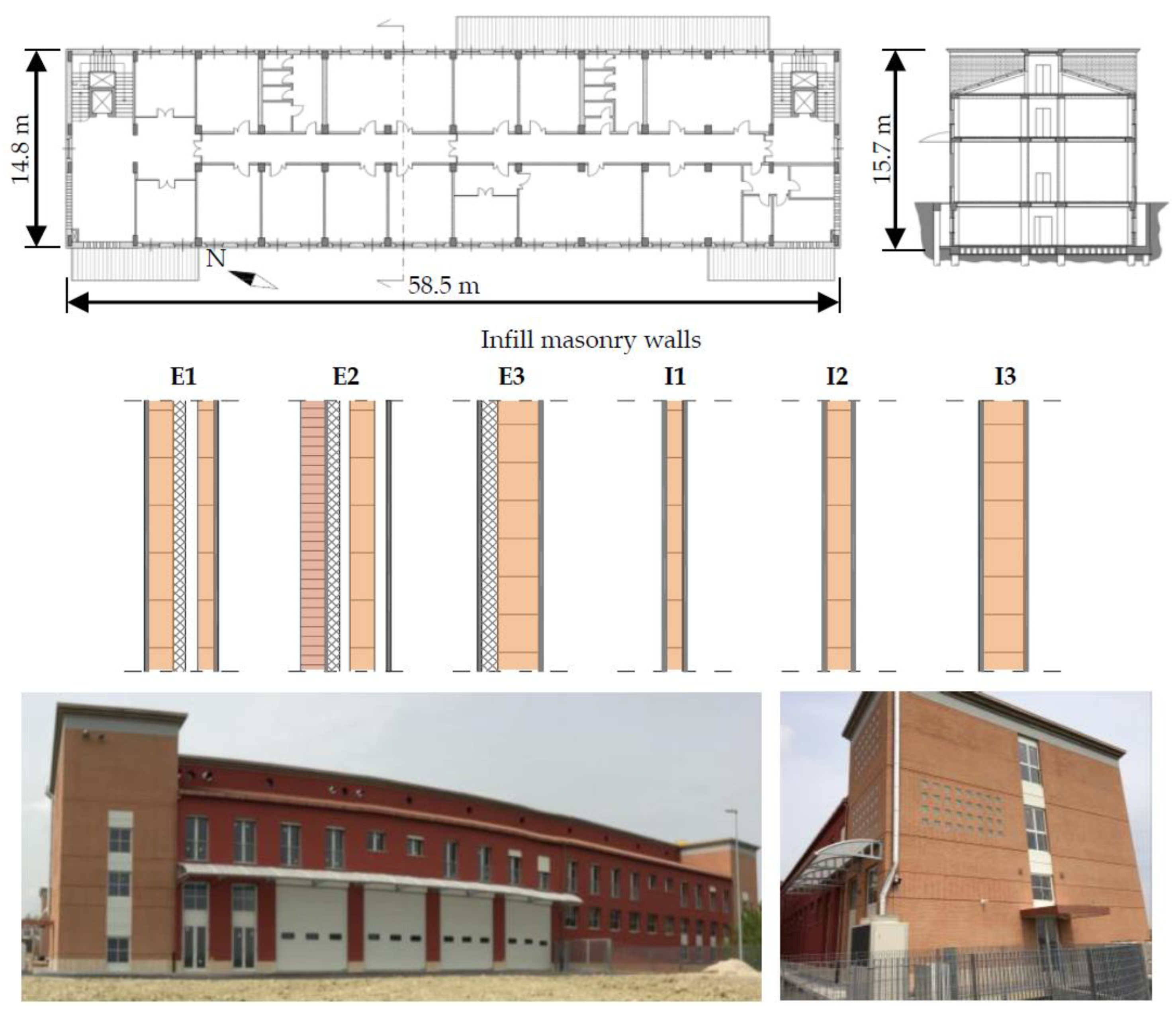
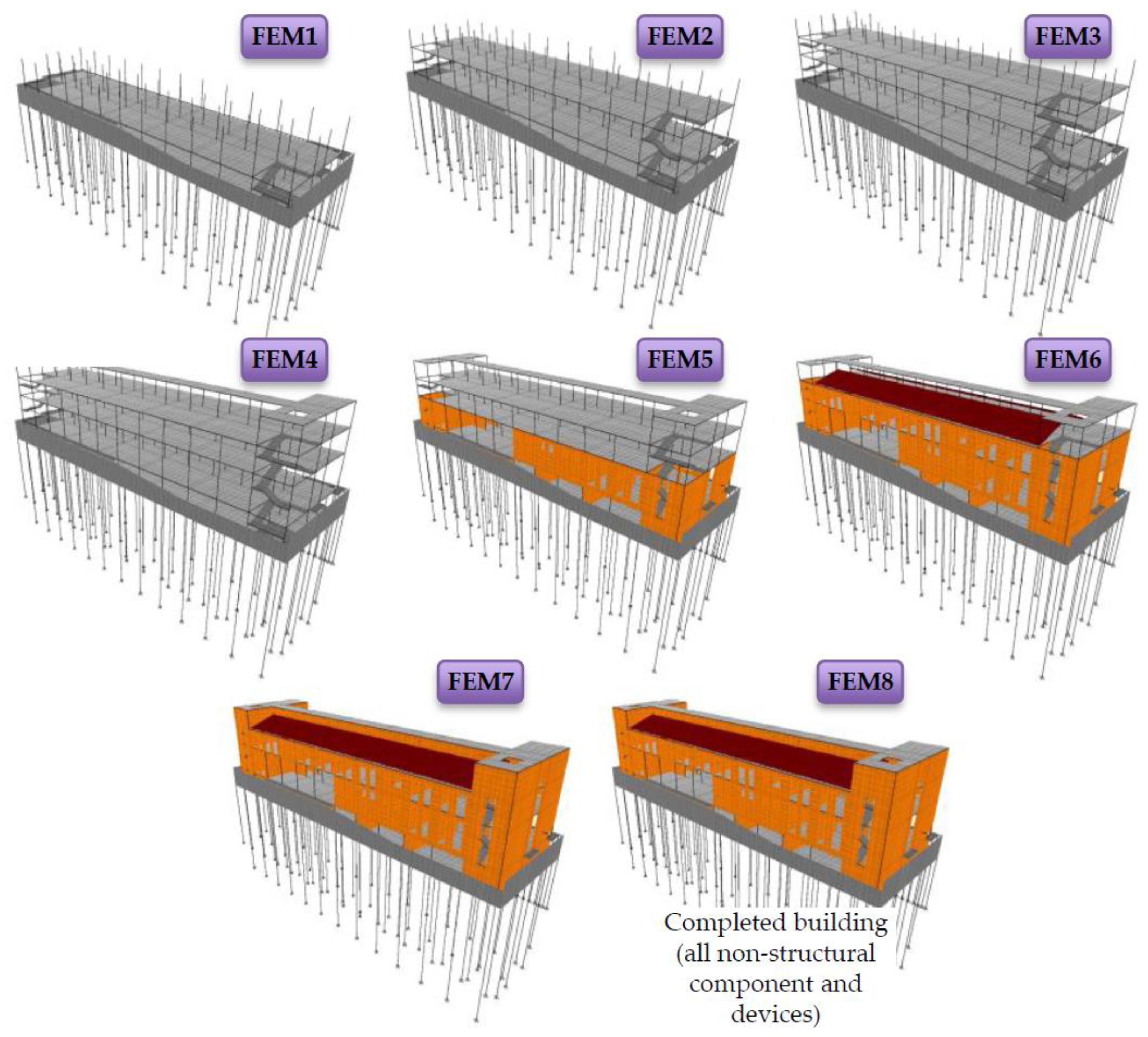

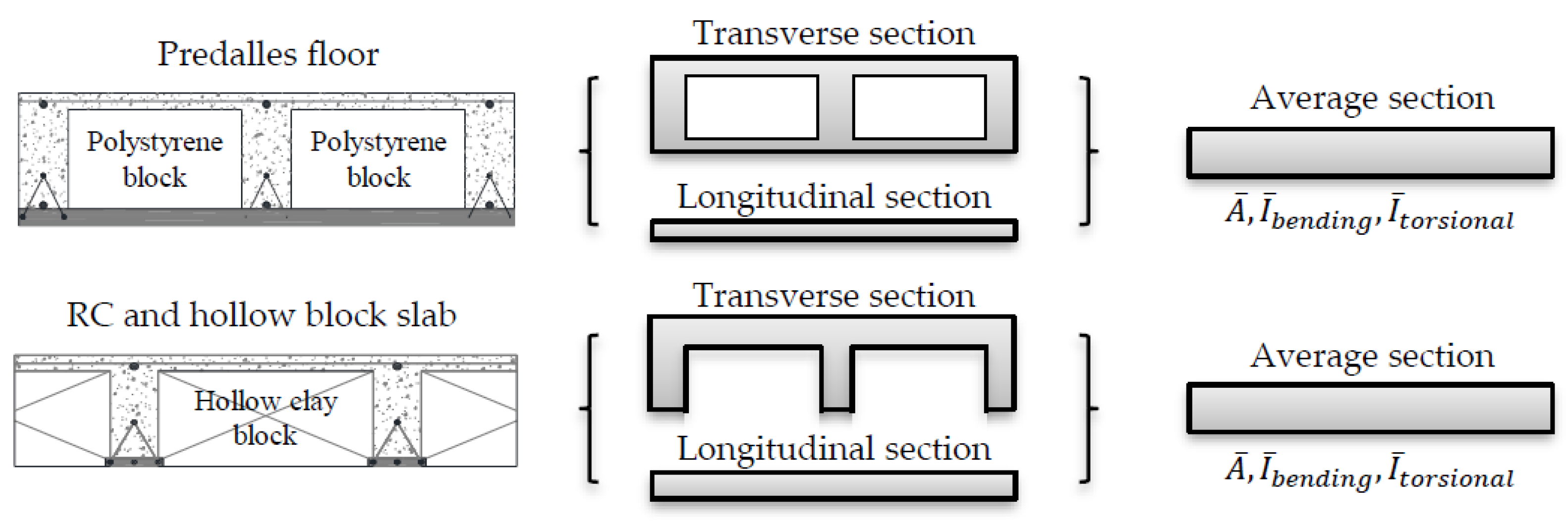

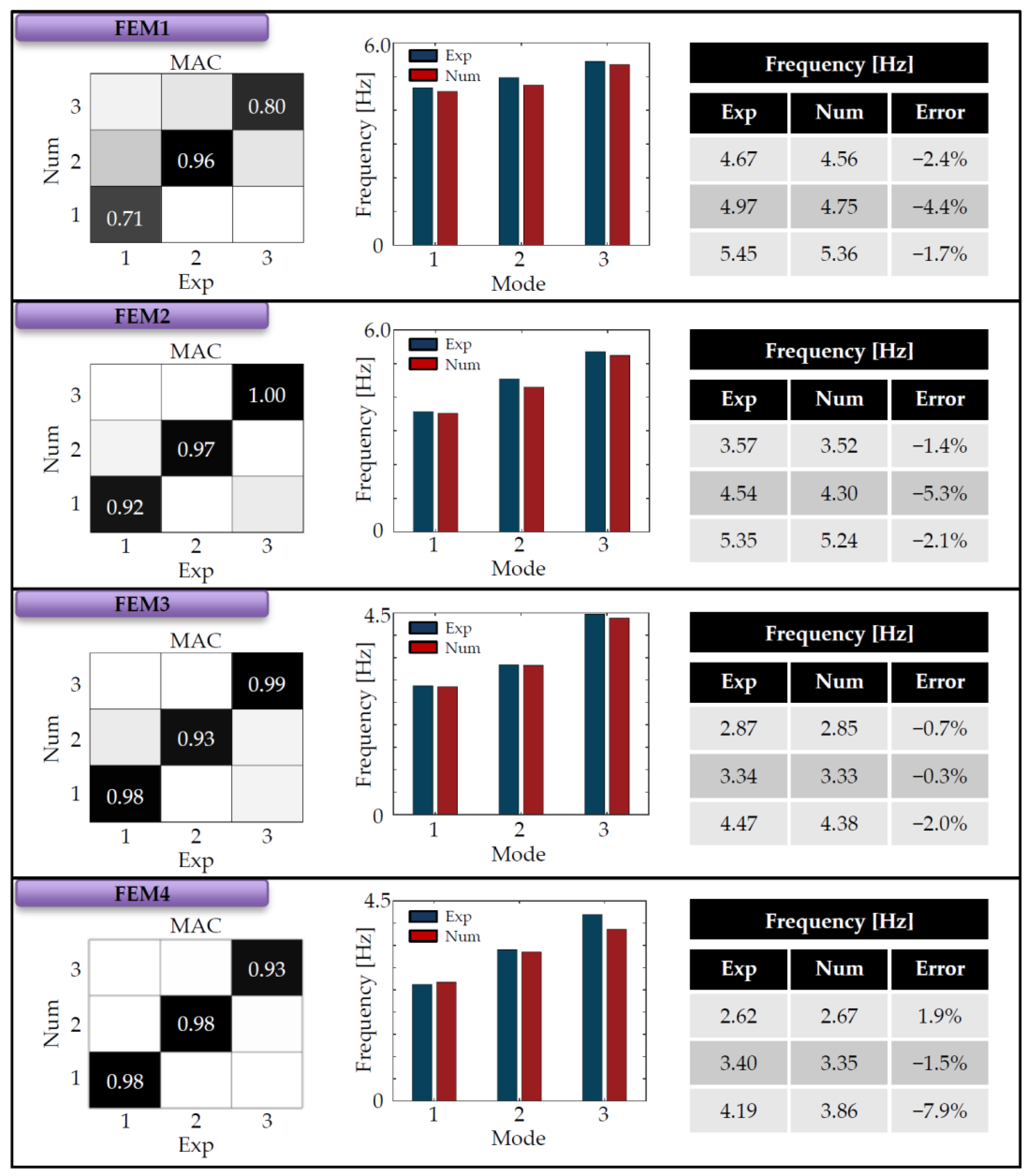

| Equations | Authors |
|---|---|
| Lydon and Balendran [57] | |
| [GPa] | Swamy and Bandyopadhyay [58] |
| [psi] concrete mass density [lbs/ft3] | Popovics [59] |
| [GPa] | Choudhauri et al. [60] |
| Construction of the Bare Frame | Construction of the Infill Walls | ||
|---|---|---|---|
| Date | Description | Date | Description |
| 11 July 2016 | Foundation system 1st and 2nd elevation columns/stairs 1st floor slab | 12 September 2016 | 1st and 2nd elevations |
| 29 July 2016 | 2nd floor slab 3rd elevation columns/stairs | 26 September 2016 | 3rd elevation |
| 22 August 2016 | 3rd floor slab 4th elevation columns/stairs | 7 November 2016 | 4th elevation |
| 25 August 2016 | 4th floor slab (roof) | 6 April 2017 | Building completed (all nonstructural elements and devices) |
| Elements | FEM1 | FEM2 | FEM3 | FEM4 | FEM5 | FEM6 | FEM7 | FEM8 |
|---|---|---|---|---|---|---|---|---|
| Foundations & walls |  |  |  |  |  |  |  |  |
| 1st elev. columns |  |  |  |  |  |  |  |  |
| 1st floor slab |  |  |  |  |  |  |  |  |
| 2nd elev. columns |  |  |  |  |  |  |  |  |
| 2nd floor slab |  |  |  |  |  |  |  |  |
| 3rd elev. columns |  |  |  |  |  |  |  |  |
| 3rd floor slab |  |  |  |  |  |  |  |  |
| 4th elev. columns |  |  |  |  |  |  |  |  |
| 4th floor slab (roof) |  |  |  |  |  |  |  |  |
| 1st elev. infills |  |  |  |  |  YP YP |  YP YP |  YP YP |  YP YP |
| 2nd elev. infills |  |  |  |  |  NP NP |  NP NP |  YP YP |  YP YP |
| 3rd elev. infills |  |  |  |  |  |  NP NP |  NP NP |  YP YP |
| 4th elev. infills |  |  |  |  |  |  |  NP NP |  YP YP |
 Yes modelled,
Yes modelled,  Not modelled, NP = no plaster, YP = yes plaster.
Not modelled, NP = no plaster, YP = yes plaster.| 6.15 × 104 | 12.4 × 104 | 26.3 × 104 | 19.3 × 104 | 17.7 × 104 | 26.1 × 104 |
| N. | Elements | FEM1 | FEM2 | FEM3 | FEM4 | FEM5 | FEM6 | FEM7 | FEM8 | |
|---|---|---|---|---|---|---|---|---|---|---|
| I | Foundations | 30.6 | 31.7 | 32.1 | 32.4 | 32.5 | 32.7 | 32.8 | 33.0 | 33.5 |
| II | 1st elev. columns | 31.2 | 32.5 | 33.2 | 33.9 | 33.9 | 34.2 | 34.4 | 34.9 | 35.6 |
| III | 1st floor slab | 31.5 | 31.1 | 32.6 | 33.6 | 33.7 | 34.2 | 34.4 | 35.0 | 36.0 |
| IV | 2nd elev. columns | 29.7 | 28.1 | 30.3 | 31.5 | 31.6 | 32.1 | 32.4 | 32.9 | 33.8 |
| V | 2nd floor slab | 32.0 | --- | 30.3 | 33.0 | 33.2 | 34.0 | 34.4 | 35.2 | 36.3 |
| VI | 3rd elev. columns | 31.4 | --- | 27.6 | 31.9 | 32.1 | 33.1 | 33.6 | 34.5 | 35.6 |
| VII | 3rd floor slab | 32.3 | --- | --- | 31.2 | 31.7 | 33.4 | 34.1 | 35.3 | 36.6 |
| VIII | 4th elev. columns | 32.0 | --- | --- | 29.6 | 30.3 | 32.7 | 33.5 | 34.8 | 36.3 |
| IX | 4th floor slab (roof) | 31.7 | --- | --- | --- | 18.8 | 30.6 | 32.3 | 34.2 | 35.9 |
| Name | Plaster | Mass Density [kN/m3] | Elastic Modulus [MPa] | Thickness [cm] |
|---|---|---|---|---|
| E1 | NP | 5.8 | 3800 | 20 |
| YP | 7 | 5000 | 24 | |
| E2 | NP | 13 | 7100 | 12 |
| YP | 12 | 10,000 | 24 | |
| E3 | NP | 6.5 | 2600 | 20 |
| YP | 7 | 4800 | 24 | |
| I1 | NP | 3.5 | 2400 | 8 |
| YP | 7.5 | 4400 | 12 | |
| I2 | NP | 6 | 5100 | 12 |
| YP | 8 | 6100 | 16 | |
| I3 | NP | 6.5 | 2600 | 20 |
| YP | 7 | 4800 | 24 |
| Numerical f [Hz] Design FEM | Experimental f [Hz] Bare Frame | Experimental f [Hz] Complete Building |
|---|---|---|
| 1.63 | 2.62 | 6.02 |
| 1.93 | 3.40 | 6.42 |
| 2.52 | 4.19 | 7.06 |
Disclaimer/Publisher’s Note: The statements, opinions and data contained in all publications are solely those of the individual author(s) and contributor(s) and not of MDPI and/or the editor(s). MDPI and/or the editor(s) disclaim responsibility for any injury to people or property resulting from any ideas, methods, instructions or products referred to in the content. |
© 2023 by the authors. Licensee MDPI, Basel, Switzerland. This article is an open access article distributed under the terms and conditions of the Creative Commons Attribution (CC BY) license (https://creativecommons.org/licenses/by/4.0/).
Share and Cite
Nicoletti, V.; Gara, F. Modelling Strategies for the Updating of Infilled RC Building FEMs Considering the Construction Phases. Buildings 2023, 13, 598. https://doi.org/10.3390/buildings13030598
Nicoletti V, Gara F. Modelling Strategies for the Updating of Infilled RC Building FEMs Considering the Construction Phases. Buildings. 2023; 13(3):598. https://doi.org/10.3390/buildings13030598
Chicago/Turabian StyleNicoletti, Vanni, and Fabrizio Gara. 2023. "Modelling Strategies for the Updating of Infilled RC Building FEMs Considering the Construction Phases" Buildings 13, no. 3: 598. https://doi.org/10.3390/buildings13030598








